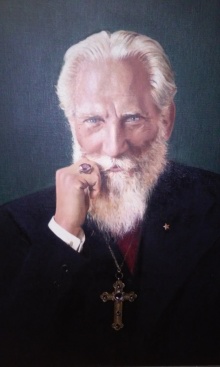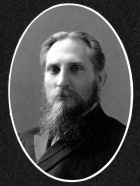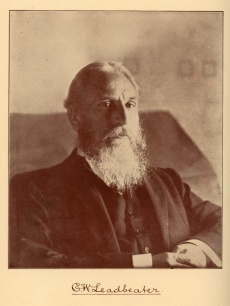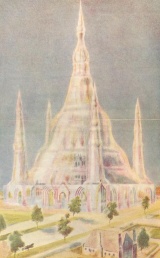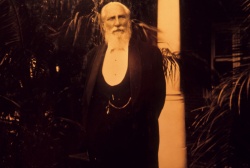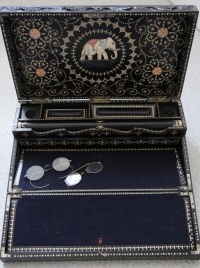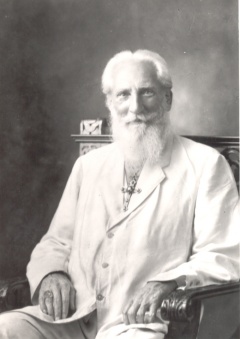Charles Webster Leadbeater: Difference between revisions
No edit summary |
No edit summary |
||
| Line 156: | Line 156: | ||
In the "outer world", there were ups and downs for him; and a particularly trying time in 1906, when his greatest colleague, [[Annie Besant]], seemed to break the bonds of a deep friendship between them. But his attitude was one of serenity, for the only thing that mattered was that he should be true to the Master's work, and not b swayed by the judgment which others formed of him.<ref>C. Jinarājadāsa, ''The "K. H." Letters," 68.</ref> | In the "outer world", there were ups and downs for him; and a particularly trying time in 1906, when his greatest colleague, [[Annie Besant]], seemed to break the bonds of a deep friendship between them. But his attitude was one of serenity, for the only thing that mattered was that he should be true to the Master's work, and not b swayed by the judgment which others formed of him.<ref>C. Jinarājadāsa, ''The "K. H." Letters," 68.</ref> | ||
</blockquote> | </blockquote> | ||
===Geoffrey Hudson=== | |||
<blockquote> | |||
Although a very great deal of what C.W. Leadbeater said and described is beyond my own limited experience, I am able to offer the testimony that I have independently become assured of the truth of certain of his teachings. The existence of the human aura, for example, and of the changes and conditions produced in it by both temporary and habitual feelings and thoughts, are undeniable facts for me. It fell to my lot for some six years to make a special study of this subject, having been drawn into collaboration with certain medical men and used as an investigator and diagnostician in London from 1923 - 1929. Again and again in the course of my investigations I received evidence of the close relationship existing between the physical body and clairvoyantly observable psychological and mental conditions. <ref>Hodson, Sandra and J. van Thiel, Mathias. <I>C.W. Leadbeater</I>, page 15</ref></br> | |||
[[File:CW Leadbeater 1.jpg|240px|right|thumb|Charles W. Leadbeater]] | [[File:CW Leadbeater 1.jpg|240px|right|thumb|Charles W. Leadbeater]] | ||
Revision as of 22:36, 22 July 2020
ARTICLE UNDER CONSTRUCTION
Charles Webster Leadbeater was an English Theosophist associated with the Theosophical Society based in Adyar, Chennai, India. He was best known for his extensive writings, his clairvoyant observations, and his involvement in "discovering" and raising Jiddu Krishnamurti.
See also Leadbeater writings.
Early life
Charles Webster Leadbeater was born in Stockport, Cheshire, England to Charles Leadbeater, a railway contractor's clerk, and his wife Emma. The date of his birth was February 16, 1854, and his christening took place on March 19, 1854.[1] The England Censuses of 1861 and 1881 confirm that year. However, in the early 1880s, Leadbeater gave his birth date as February 17, 1847. That date appears in the 1891 census, in his passport, and is also reflected in passenger lists and other records. The earlier year, 1847, is the same year that Leadbeater's close associate Annie Besant was born.
According to C. Jinarajadasa, the Leadbeater family was Norman French in origin, with name Le Batre (the builder), later Englished to Leadbeater. One branch of the family followed "Prince Charlie" of the Stuart dynasty, and adopted the custom to christen the eldest son "Charles".[2]
In 1858 the family went to Brazil, and his father died a few years later, in 1862. When a bank collapse reduced his mother to poverty, Leadbeater went to work as a bank clerk at Williams Deacons & Co. to support their household.[3]
On December 21, 1879, following the footsteps of his uncle, Mr. Leadbeater was ordained a priest in the Church of England. He was assigned as "a curate in a parish in Hampshire called Bramshott, and lived with this mother at a cottage called 'Hartford'... The Rector of the parish was the Rev. W. W. Capes... his wife Mrs. Capes was C. W. L.'s aunt."[4] While working as a curate, he established organizations to occupy the local boys and girls, including the "Union Jack Field Club" for natural history studies; the Church Society for wholesome entertainment with songs and stories; and the Church of England Temperance Society. One of the boys, James W. Matley, wrote vividly of those activities, and of field trips to London theaters and the seaside; stargazing with CWL's large telescope; and all sorts of games, boating, cricket, and tennis. Mr. Leadbeater tutored young Matley in French, trigonometry, and navigation, and helped him find employment at sea.[5]
Despite his connection to the Church of England, Mr. Leadbeater always kept an open mind for things that did not fall within orthodox Christianity, such as psychic and Spiritualistic phenomena. Whenever he heard of ghosts or haunted houses he conducted his own investigations. He also attended the lectures given by Annie Besant (then an atheist) at the Hall of Science.
Introduction to Theosophy, Blavatsky, and the Masters
In 1883, Mr Leadbeater read a copy of A. P. Sinnett’s book The Occult World and became very interested in Theosophy. He met the author, who was at the time receiving letters from two of the Masters of Wisdom, and joined the London Lodge of the Theosophical Society, in November 1883. He was immediately attracted to the ideal of the Masters and felt that each "should set before himself the definite intention of becoming a pupil of one of the great Adept Masters."[6]
One day, while investigating Spiritualistic phenomena with renowned medium and Theosophist William Eglinton, one of the latter's Spirit-guides named "Ernest" assured he could transmit a letter from Mr. Leadbeater to the Masters. On March 3, 1884, he wrote a letter to Master K.H. offering himself as a chela so that he could "learn more of the truth". He sent the letter to Mr. Eglinton, who placed it in a box he had for Ernest's use, and from which it eventually disappeared. Several months passed and he did not receive any reply.
In the meantime, he met Mme. Blavatsky (HPB), who arrived at London on April and unexpectedly attended a rather troubled meeting of the London Lodge where new officers were being elected. He described the "truly tremendous impression" that Mme. Blavatsky had on him. Her plan was to stay in Europe until November 1st of that year, when she was to sail for India. On October 30, two days before her departure, Mr. Leadbeater traveled to London to say good-bye to HPB. He stayed the night with the Sinnetts. That evening HPB informed him that "D.K." had said that the Master had sent a reply to his letter of March 3rd. On the next day, Mr. Leadbeater returned to his house and found the Master's letter, which opened as follows:
Last spring – March the 3rd – you wrote a letter to me and entrusted it to "Ernest". Tho' the paper itself never reached me – nor was it ever likely to, considering the nature of the messenger – its contents have.[7]
In the letter the Master said that a member should "force" the Master to accept him as a chela by doing good works for humanity, working on self-purification, and making sacrifices for the Theosophical cause. He also warned CWL that he would have to atone for the collective karma of the Christian clergy to which he belonged. Finally, the Master suggested that he could go to Adyar to work for a few months. The letter closes with the following words:
So now choose and grasp your own destiny, and may our Lord's the Tathagata's memory aid you to decide for the best. K. H.[8]
He decided to follow the Master's suggestion. However, he found out he could not take a leave of absence from his position in the local Church school, of which he was manager – he would have to resign to it. He decided to go back to London to talk to Mme. Blavatsky (who was leaving London the next morning) and, through her agency, ask the Master whether he wanted him to take this more drastic action. Late that night, in a gathering of some Theosophists that had come to say farewell to HPB, the answer was precipitated on her open hand, witnessed by several people. It said:
Since your intuition led you in the right direction and made you understand that it was my desire you should go to Adyar immediately – I may say more. The sooner you go the better. Do not lose one day more than you can help. Sail on the 5th if possible. Join Upasika at Alexandria. Let no one know you are going and may the blessing of our Lord, and my poor blessing shield you from every evil in your new life.
Greeting to you my new chela. K.H. Show my notes to no one.[9]
Early Theosophical work
In 1886 Leadbeater was a member of the small headquarters staff at Adyar, along with President-Founder Colonel Olcott, A. J. Cooper-Oakley, and a few Indian workers. Very little money was coming into Adyar in those days apart from small incomes made selling books and coconuts. "When the [carriage] horses died one after another, for several months Mr. Leadbeater, as acting editor of The Theosophist had to walk the seven miles to Madras with proofs, etc."[10]
Sri Lanka
During 1886, Leadbeater was assigned to work in Ceylon [now Sri Lanka]. At that time he received a note from Master K. H. precipitated across the last page of a letter to CWL from Madame Blavatsky, who was then in Elberfeld, Germany. The brief message said, "Take courage. I am pleased with you. Keep your own counsel, and believe in your better intuitions. The little man has failed and will reap his reward. Silence meanwhile."
When Olcott founded Ananda College in Colombo, Ceylon (now Sri Lanka) on November 1, 1886, he installed Leadbeater as the first principal. Leadbeater also served as General Secretary of the Theosophical Society in Ceylon from 1888-1889.[11]
Tutoring in London
In 1890, A. P. Sinnett asked Mr. Leadbeater to return from India to England to tutor his son Denny and George Arundale, Leadbeater brought with him Curuppumullage Jinarājadāsa, known as "Raja." The three boys were close in age: Raja was born in 1875, Denny in 1877, and George in 1878. For two years, Leadbeater and Raja lived in the Sinnett household, but after that they moved into tiny quarters meagerly supported by Leadbeater's work giving English languages to foreigners while Raja attended classes to prepare for university.[12]
Leadbeater was Secretary of the London Lodge, and with Raja participated in its Inner Group. They were present at the "intimate and informal gatherings of the Group which were held on most Sunday mornings in Mr. Sinnett's library for discussion."[13]
Occult training
In his book How Theosophy Came to Me, Leadbeater described the training that allowed him to develop clairvoyance:
One day, however, when the Master Kuthumi honoured me with a visit, He asked me whether I had ever attempted a certain kind of meditation connected with the development of the mysterious power called kundalini. I had of course heard of that power, but knew very little about it, and at any rate supposed it to be absolutely out of reach for Western people. However, He recommended me to make a few efforts along certain lines, which He pledged me not to divulge to anyone else except with His direct authorization, and told me that He would Himself watch over those efforts to see that no danger should ensue.
Naturally I took the hint, and worked away steadily, and I think I may say intensely, at that particular kind of meditation day after day. I must admit that it was very hard work and sometimes distinctly painful, but of course I persevered, and in due course began to achieve the results that I had been led to expect. Certain channels had to be opened and certain partitions broken down; I was told that forty days was a fair estimate of the average time required if the effort was really energetic and persevering. I worked at it for forty-two days, and seemed to myself to be on the brink of the final victory, when the Master Himself intervened and performed the final act of breaking through which completed the process, and enabled me thereafter to use astral sight while still retaining full consciousness in the physical body—which is equivalent to saying that the astral consciousness and memory became continuous whether the physical body was awake or asleep. I was given to understand that my own effort would have enabled me to break through in twenty-four hours longer, but that the Master interfered because He wished to employ me at once in a certain piece of work.
It must not for a moment be supposed, however, that the attainment of this particular power was the end of the occult training. On the contrary, it proved to be only the beginning of a year of the hardest work that I have ever known. It will be understood that I lived there in the octagonal room by the river-side alone for many long hours every day, and practically secure from any interruption except at the meal-times which I have mentioned. Several Masters were so gracious as to visit me during that period and to offer me various hints; but it was the Master Djwal Kul who gave most of the necessary instruction. It may be that He was moved to this act of kindness because of my close association with Him in my last life, when I studied under Him in the Pythagorean school which He established in Athens, and even had the honour of managing it after His death. I know not how to thank Him for the enormous amount of care and trouble which He took in my psychic education; patiently and over and over again He would make a vivid thought-form, and say to me: “What do you see?” And when I described it to the best of my ability, would come again and again the comment: “No, no, you are not seeing true; you are not seeing all; dig deeper into yourself, use your mental vision as well as your astral; press just a little further, a little higher.”
This process often had to be many times repeated before my mentor was satisfied. The pupil has to be tested in all sorts of ways and under all conceivable conditions; indeed, towards the end of the tuition sportive nature-spirits are specially called in and ordered in every way possible to endeavour to confuse or mislead the seer. Unquestionably it is hard work, and the strain which it imposes is, I suppose, about as great as a human being can safely endure; but the result achieved is assuredly far more than worth while, for it leads directly up to the union of the lower and the higher self and produces an utter certainty of knowledge based upon experience which no future happenings can ever shake.[14]
Accusations, resignation and return to the Society
In early 1900, some adolescents were put under Leadbeater's education to be trained in occultism. Some of them, who felt the pressure of sexual thoughts, were advised to masturbate to ease the urge. This advice was controversial at a time when even doctors held the opinion that masturbation could lead to insanity. Leadbeater argued that this view was mistaken, and that the accepted alternative of having encounters with the prostitutes was degrading to the women, and created bad karmic and moral consequences for those involved in illegitimate sex.
He also maintained that, when masturbation was dealt with as a purely physiological act, it was less problematic from an occult point of view than indulging in sexual thoughts. This view finds precedent in the writings of H. P. Blavatsky. When asked about the "sexual force" she answered:
This force is vital, creative, and a sort of reservoir. It may be lost by mental action as well as by physical. In fact its finer part is dissipated by mental imaginings, while physical acts only draw off the gross part, that which is the (upadhi) for the finer.[15]
In 1906, when the parents learned about these practices, some became very upset. A commission of the American branch of the Society was appointed to investigate the facts causing great controversy. Leadbeater offered his resignation to "save society from shame," and Henry Steel Olcott accepted it. Later, in 1909, CWL was reinstated in the Theosophical Society, under the presidency of Annie Besant.
International lecture tours
Krishnamurti
In May, 1909, C. W. Leadbeater ran into 13-year old J. Krishnamurti who was playing in the beach, exhibiting "the most wonderful aura he has ever seen, without a particle of selfishness." Although Theosophist and scholar Ernest Wood, who had tried to help the boy with his homework, considered him to be dim-witted, Leadbeater predicted that Krishnamurti would become a spiritual teacher and a great orator "much greater" than even Annie Besant.[16]
CWL nourished, educated and trained young Krishnamurti and his brother Nityananda. Another controversy was raised by an Indian servant in 1913. The reason was that CWL taught the two boys to take showers naked, so that they could wash properly, which opposed the traditional Indian custom of keeping a piece of cloth around the waist. This was used by the father against him in a case in India in relation to the legal guardianship of the brothers. The judge regarded that these were "immoral ideas" and ruled against Besant and Leadbeater.[17][18] Annie Besant appealed to the court in London and won the case.
As Krishnamurti became a teenager, he gradually began to resent the discipline imposed on him. He left Adyar to live in Europe and Leadbeater moved to Australia. Krishnamurti grew rebellious about his supposed spiritual role and his relationship with CWL got more distant. But in 1922 this changed. Krishnamurti arrived to Sydney in April to attend the Australian National Convention. There, he saw again CWL after about ten years. He wrote in a letter to Lady Emily: C.W.L. was "just the same", and added: "He is much whiter in hair, just as jovial & beaming with happiness. He was very glad to see us. He took my arm & held on to it & introduced me to all with a 'voilà' in his tone. I was very glad to see him too."[19]
During one of the meetings at the Convention an argument broke out concerning Leadbeater. J. Krishnamurti, who was present, declared that he knew Leadbeater better than most of those present, and that he could speak with some authority. As he reported later, he then declared that CWL "was one of the purest and one of the greatest men I had ever met. His clairvoyance may be doubted but not his purity."[20]
After Krishnamurti left Australia he began to meditate and regain his touch with the Masters, as a result of which he had a life-altering experience. After this he wrote to CWL:
I began consciously and deliberately to destroy the wrong accumulations of the past years since I had the misfortune of leaving you. Here let me acknowledge with shame that my feelings towards you were not what they should have been. Now, they are wholly different, I think I love and respect you as mighty few people do. My love for you when we first met at Adyar has returned bringing with it the love from the past. Please don't think that I am writing mere platitudes and worn out phrases. They are not and you, my dearest brother, know me, in fact better than myself. I wish, with all my heart, that I could see you now.[21]
Liberal Catholic Church
In 1914 Leadbeater moved to Sydney, Australia, and attracted many people of a younger generation by his lectures, his more informal talks and the guidance he was able to give. It was in Sydney that he entered on a new phase of his life story.
Already in Europe he had been fascinated to observe the inner effects of church services and other ceremonies as his psychic capacities led him to see and interpret them. When it came to the Catholic Mass, he saw the whole machinery of sacramental and eucharistic rites as having been devised originally for the purpose of releasing uplifting inner forces to help the human community and draw it closer to inner and more spiritual worlds. [22]
In 1920 he published The Science of the Sacraments, which described the astral forms that he saw when the Christian sacraments were performed. He found the Eucharist, or mass, to be particularly powerful. “It is a plan,” he wrote, “for helping on the evolution of the world by the frequent outpouring of floods of spiritual force.” When properly enacted, he said, the ceremony created an astral “thought-edifice” that can take on any number of variations, although it is usually based on a foursquare ground plan surmounted with a dome. To create as powerful a vehicle as possible, the celebrant needs to perform the Eucharist correctly and with intention (as opposed to rote mechanical enactment).
In 1915 he was joined in Sydney by James Ingall Wedgwood, a theosophist and a keen ritualist. Wedgwood initiated Leadbeater into the degrees and ceremonies of Co-Freemasonry which became a new field of activity for Leadbeater. Wedgewood had been deeply involved in the Old Catholic Church in England, and in February 1916 was consecrated bishop in Sydney. Wedgewood and Leadbeater worked together to revise the Old Catholic liturgy, guided to a considerable extent by what they could observe psychically of the inner effects of the various rites and services. A constitution and a statement of principles were drawn up.[23] “We set to work to eliminate the many features which from our point of view disfigure and weaken the older liturgies,” Wedgwood later wrote. “References to fear of God, to His wrath and to everlasting damnation were taken out, also the constant insistence on the sinfulness and worthlessness of man.” [24] The resulting liturgy was published in 1919.
A big number of those who comprised the clergy of the small new church were members of the Theosophical Society or at least sympathetic with its ideals. But there were others who were actively hostile to churches as such, endorsing Madam Blavatsky’s criticism to churches and clergymen. Because of a request to Archbishop the Old Catholic Church to continue their work as part of the Old Catholic Church was denied, the name of the church was changed to the Liberal Catholic Church, and it came to be established on every continent. This Church required no specific commitment as to doctrine or belief from anybody who joins in its services or approaches its altars.
The Church, seen as a means of changing lives and enabling spiritual reality more richly to pervade secula existence, now became a major preoccupation for Leadbeater, who was appointed the Church’s regionary bishop for Australia. He continued to lecture and work for Theosophical Society and concern himself with the training of young people. [25]
Years at The Manor
In 1922 a large house called “The Manor” was acquired, overlooking Sydney Harbour, and there Bishop Leadbeater lived with a resident community of those who came from many countries to learn from him, including a high proportion of young people of both sexes. At the same time he succeeded Wedgewood as Presiding Bishop of the Liberal Catholic Church. [26]
This house was located in the fashionable suburb of Mosman and it was huge, rambling and distinctly strange. Much of the time at The Manor was spent by occupants waiting for Leadbeater to appear from his room which opened on the verandah. Small groups gathered around the door, anxious not to miss the opportunity of a word with him. Occasionally Leadbeater would lead an expedition into the surrounding parkland.
When the Australian Theosophical Convention was held in Sydney over Easter 1929 delegates were taken on a guided tour of The Manor and visited the “famous metal lined room” which Leadbeater had vacated. It was to be turned into a Temple. The Manor was considered the Center for the Southern Hemisphere, and “the representative on the physical plan of Shamballa”. It’s focus was the “highly magnetized Temple” and the Center was protected by a special angel.
The Manor remains a center of the Esoteric Section, its Heads having included Jinarajadasa, Dr. Van den Broeck, James Perkins, and Jack Patterson. There is still a chapel in the basement, and the Egyptian Rite still meets there regularly.[27]
Return to Adyar
In 1929, Annie Besant wrote:
My Brother Leadbeater, after nearly 16 years' residence in Australia, has returned to Adyar to make his home here as of yore. For several years he has been living in Australia for nine months and making a three months' trip to Adyar. Now he retires to reverse that process. I am happy to have him with me again, for he is always a tower of strength and a fount of wisdom.[28]
Writings
Mr. Leadbeater wrote an extensive body of work, which is listed in Leadbeater writings. Often he collaborated with Annie Besant in writing about esoteric subjects. Young people such as Basil Hodgson-Smith and Fritz Kunz assisted with his massive correspondence, and Ernest Wood helped to compile some of the books. When touring, Leadbeater and his assistants carried typewriters, papers, and other supplies. A lap desk was indispensable for organizing stationery, envelopes, stamps, and writing implements.
Later years
At the beginning of 1934 Leadbeater left from India for Australia extremely ill and frail. When he arrived in Perth, he was very weak and he summoned Harold Morton, who had been his secretary in Sydney and was General Secretary of the TS in Australia. He saw him the last time on February 29th. Leadbeater passed away on March 1 His mortal remains, in the form of ashes, were distributed between the Manor, Adyar and Huizen, with a portion being placed behind a memorial tablet on the wall of the Liberal Catholic Church in Perth. [29]
Personal comments
C. Jinarājadāsa
During a close and intimate collaboration with him of forty-five years, I never noticed a single moment when his utter trust in the Master wavered by even the tiniest flicker, nor when his enthusiasm for the Master's work flagged...
In the "outer world", there were ups and downs for him; and a particularly trying time in 1906, when his greatest colleague, Annie Besant, seemed to break the bonds of a deep friendship between them. But his attitude was one of serenity, for the only thing that mattered was that he should be true to the Master's work, and not b swayed by the judgment which others formed of him.[30]
Geoffrey Hudson
Although a very great deal of what C.W. Leadbeater said and described is beyond my own limited experience, I am able to offer the testimony that I have independently become assured of the truth of certain of his teachings. The existence of the human aura, for example, and of the changes and conditions produced in it by both temporary and habitual feelings and thoughts, are undeniable facts for me. It fell to my lot for some six years to make a special study of this subject, having been drawn into collaboration with certain medical men and used as an investigator and diagnostician in London from 1923 - 1929. Again and again in the course of my investigations I received evidence of the close relationship existing between the physical body and clairvoyantly observable psychological and mental conditions. [31]
Honors and awards
Ananda College in Colombo, Sri Lanka awards the C. W. Leadbeater Challenge Trophy in honor of the first principal of the school.
The large 3-story residential building for visitors at Adyar is called Leadbeater Chambers. It was the first concrete building of its size in India, and the cornerstone was laid March 17, 1910 by Annie Besant.
Numerous Theosophical lodges have been named after Mr. Leadbeater. In the United States, there were Leadbeater Lodges in Chicago, Houston, New York City, and Jacksonville, Florida.[32]
Additional resources
- Leadbeater,Charles Webster at Theosophy World
Books
- Jinarājadāsa, C. The "K. H." Letters to C. W. Leadbeater (Adyar, Madras, India: The Theosophical Publishing House, 1980. This volume is a thoughtful analysis of the three letters sent to Leadbeater by Master K. H., all of which were previously published in Letters from the Masters of the Wisdom, 1881-1888 in 1919:
- LMW1 Letter 7 – October 31, 1884 – response to questions about chelaship.
- LMW1 Letter 8 – November 1, 1884 – instructions to go to Adyar.
- LMW1 Letter 50 – June 23, 1886 – note of encouragement.
- Oliveira, Pedro. CWL Speaks: C. W. Leadbeater's Correspondence Concerning the 1906 Crisis in the Theosophical Society. 2018. Foreword by Robert Ellwood.
- Tillett, Gregory. The Elder Brother: a Biography of Charles Webster Leadbeater. London; Boston: Routledge & K. Paul, 1982.
Articles and pamphlets
- "An Appreciation of C. W. Leadbeater" by Geoffrey Hodson
- "C. W. Leadbeater - A Great Occultist" Compiled by Sandra Hodson and Mathias J. van Thiel
- "C.W. Leadbeater in Retrospect" By Hugh Shearman
Websites
- CWL World is a rich source of information, including documents and photographs.
- Articles by and about C.W. Leadbeater at Katinkahesselink.net
- C. W. Leadbeater,1854-1934, a blog-style website established by Gregory John Tillett to follow up on his book The Elder Brother. Since the author died in 2018(?), the best access to this website in the future may be through the Internet Archive snapshot dated December 12, 2018.
Audio
- To Those Who Mourn by C. W. Leadbeater
- Occult Commentaries by C. W. Leadbeater, G. S. Arundale & C. Jinarajadasa
Video
- "C W Leadbeater, Annie Besant, Krishnamurti - Theosophy UK". Footage of Annie Besant, C. W. Leadbeater, and J. Krishnamurti in mid-1920s, found in the archives of The International Theosophical Centre, Naarden, Netherlands. Available from Theosophy World Resource Centre.
Notes
- ↑ England, Select Births and Christenings, 1538-1975.
- ↑ Curuppumullage Jinarājadāsa, The "K. H." Letters to C. W. Leadbeater (Adyar, Madras: The Theosophical Publishing House, 1980), 53.
- ↑ Jinarājadāsa, The "K. H." Letters, 17.
- ↑ James W. Matley "C. W. Leadbeater at Bramshott Parish," Appendix I of C. Jinarājadāsa, The "K. H." Letters to C. W. Leadbeater (Adyar, Madras, India: Theosophical Publishing House, 1980), 105.
- ↑ Matley, 106-109.
- ↑ C. W. Leadbeater, How Theosophy Came to Me.
- ↑ Jinarājadāsa, The "K. H." Letters, 12.
- ↑ Jinarājadāsa, The "K. H." Letters, 14.
- ↑ Jinarājadāsa, The "K. H." Letters, 52.
- ↑ C. Jinarājadāsa, "Administration of Adyar Headquarters," The American Theosophist 36.5 (April, 1947), 73-75, 82.
- ↑ "General Secretaries". The Theosophical Year Book, 1938. (Adyar, Madras, India: Theosophical Publishing House, 1938), 152.
- ↑ Jinarājadāsa, The "K. H." Letters, 68.
- ↑ C. Jinarājadāsa, The "K. H." Letters," 74.
- ↑ Charles Webster Leadbeater, How Theosophy Came to Me, Chapter IX, "Unexpected Development" and "Psychic Training".
- ↑ Helena Petrovna Blavatsky, Collected Writings vol. IX (Wheaton, IL: Theosophical Publishing House, 1974), 108.
- ↑ Mary Lutyens, Krishnamurti: The Years of Awakening (New York: Farrar, Straus and Giroux, 1975), 21.
- ↑ «Naranian vs. Besant», lettera scritta da Annie Besant al Times, 2 giugno 1913, p.7.
- ↑ Kersey, John. 'Arnold Harris Mathew and the Old Catholic Movement in England 1908-52. p.199.
- ↑ Mary Lutyens, Krishnamurti: The Years of Awakening (New York: Farrar, Straus and Giroux, 1975), 140.
- ↑ Mary Lutyens, Krishnamurti: The Years of Awakening (New York: Farrar, Straus and Giroux, 1975), 143.
- ↑ Mary Lutyens, Krishnamurti: The Years of Awakening (New York: Farrar, Straus and Giroux, 1975), 160.
- ↑ Shearman, Hugh. Charles Webster Leadbeater. A Biography. The St. Alban Press, 1980. Pages 24-25
- ↑ Shearman, Hugh. Charles Webster Leadbeater. A Biography. The St. Alban Press, 1980. Pages 25-26
- ↑ Smoley, Richard. The Liberal Catholic Church Celebrates Its Centenary. http://www.innerchristianity.com/blog/posts/30966. Accessed on 7/2/20
- ↑ Shearman, Hugh. Charles Webster Leadbeater. A Biography. The St. Alban Press, 1980. Pages 24-29
- ↑ Shearman, Hugh. Charles Webster Leadbeater. A Biography. The St. Alban Press, 1980. Pages 30-31
- ↑ Shearman, Hugh. Charles Webster Leadbeater. A Biography. The St. Alban Press, 1980. Pages 204- 260
- ↑ General Report of the Theosophical Society, 1929, page 21-22.
- ↑ Shearman, Hugh. Charles Webster Leadbeater. A Biography. The St. Alban Press, 1980. Pages 204- 260
- ↑ C. Jinarājadāsa, The "K. H." Letters," 68.
- ↑ Hodson, Sandra and J. van Thiel, Mathias. C.W. Leadbeater, page 15
- ↑ National Secretary records. Theosophical Society in America.
